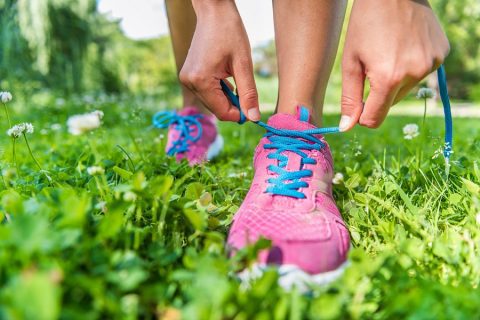Running for Beginners: 7 Tips for Getting Started

Running seems like it’s an easy thing to get into—you just slide on some sneakers and hit the sidewalk, right? Well, yes—but no. If you want to make running a part of your daily life, it’s a process you have to commit to.
I don’t consider myself a seasoned runner by any means. I’ve never run a race longer than a 5K, and I’ve only really been into running for a few years now. That being said, I love to run. I never thought I would, but I actually look forward to it and try to get at least one mile under my feet every day.
I don’t want to run a long race right now; I enjoy just running as far and as fast as I want to on any given day, but running is running. And if you want to make it something you can do with relative ease, there are a few lessons I’ve learned and want to share.
1. Good Shoes are Everything
You won’t run far without a good pair of running shoes. A poorly fitting pair of running shoes will end your running career before you even know it. The best way to find a good pair of shoes is to first know what you need from a shoe. Do you have a high arch? Do you want something lightweight or with a lot of structure? There’s actually a lot to consider when it comes to shoes.
I recommend heading to a specialty running store so you can speak with a sales associate who really knows the shoes and what they provide a runner. Place likes FinishLine are okay for shoes you just want to look cute in, but a store that truly focuses on shoes for runners is where you need to shop.
If you don’t want to visit a store like that, look into the Brooks Running Shoes website. The website has a questionnaire you can fill out to determine what kind of shoe you need. I did this for my first pair of serious running shoes, and it worked wonders. I wear the pair recommended for my high arches and slow-but-steady running style for just about every single run.
2. Good Music Makes All the Difference
This might not seem like a huge life-altering tip, but the music you listen to while you run is important. The tempo of the music affects your speed, and music you enjoy actually leads to longer workouts. Put together a playlist of fast-paced upbeat songs you like—or even try out Spotify Running (found in the regular Spotify app). It actually detects your speed and chooses a playlist that matches it.
I’d also like to note that it’s a good idea to have some running playlists for the days when you’re angry or upset. Sometimes you just need some angry, fast-paced tunes to help you run out any frustration you’re dealing with.
3. Pace Yourself From the Beginning
I mean this in more ways than one. Of course, if you want to run distance, then you need to learn how to pace yourself the whole time so you don’t burn out before reaching your distance goal.
But it’s also important to pace how quickly you start a running plan. You have to start off on the light side. If you haven’t been running in a long time, then don’t head out there with the mindset you can crank out a six-minute mile right away. You can’t, and you’ll probably hurt yourself. You also don’t need to try to run five miles or run non-stop. Your muscles need time to get used to the act of running and build strength.
Go easy the first week or two before you try to push yourself super hard. Let your legs adjust. It’s best to follow a running plan that has you alternate walking and jogging for a period of time or set the simple goal of walking/jogging one mile.
4. Don’t Give Up
Aside from pacing yourself, it’s also important to be very consistent. You can’t run three days one week, one day the next, take two weeks off, and then come back to bust out three miles. In order to build your aerobic endurance and physical strength, you have to be dedicated. Running the same number of days each week, alternating days, or increasing your distance by a set amount every few days is the best way to truly become a runner.
5. Form, Form, Form
Bad form is common among runners. Even those who’ve been running for years can have bad form without realizing it. When you start running, take the time to really focus on good form so you can create a habit out of it. Otherwise, your running future will be much harder than it needs to be. Bad form leads to injury and slower times. For example, you can experience annoying knee pain during a run and even strain your knees simply from the wrong form.
Good form means standing tall with your shoulders pulled back and down and arms gently bent at a 90-degree angle and casually pumping back and forth with each step. As you run, it’s important to land on the middle of your foot with your feet in line with your knees as they hit the ground.
I ran for months before I realized my form was terrible. My shoulders always ached during my runs, and my feet often cramped. Once I figured out I wasn’t standing up straight and that I needed better running shoes, those pains ended and I could enjoy my runs.
6. Fuel Your Body Properly
Running isn’t any different from other forms of exercise when it comes to the importance of nutrition. You have to eat the right foods in order for your body to perform. While some foods are universally good for runners to eat, it’s also important to listen to what your body tells you. For instance, I can’t eat anything high in acid within 12 hours before a run. If I do I end up with really painful acid reflux and it ruins my run for me.
A few hours before your run, eat a snack full of healthy carbohydrates. I’m a fan of peanut butter with crackers or peanut butter with a banana. But you can also have something else, like pretzels and peanuts. The important thing is that it has carbs for your body to use as fuel and some protein to help fend off hunger while you’re running.
The snack you eat beforehand isn’t the only meal to worry about though. After a run, you need something high in protein to repair your muscles so they can perform in the next run. And what you eat on a daily basis has a big impact on how you’re going to feel while running. Make sure you’re eating healthy foods that won’t bog you down or make you pack on the pounds despite the exercise.
7. Know Your Why, and Keep It in Mind
It’s not easy to become comfortable with the discomfort of running. There are going to be days when a run is the last thing you want to do. Sometimes you’re going to doubt your ability to run faster or further. By knowing why you want to be a runner and repeating that to yourself during those moments, you can overcome the barriers and improve little by little every day.
Don’t give up. Take care of your body. Take it slow. Learn how to do things properly. And always remember why you started in the first place. It doesn’t matter if you go on to crush marathons or simply jog through the neighborhood with your dog. You’ll be a runner either way.
Follow Terra on Instagram: @terrabrown3
Last modified on June 4th, 2018






Show Comments +